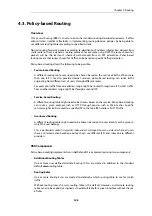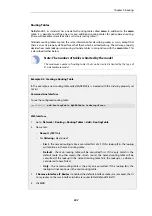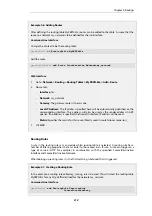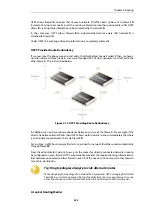
different metric. The route with the lowest metric is chosen first and when that route's
interface limits are exceeded, the route with the next highest metric is then chosen.
When that new route's interface limits are also exceeded then the route with the next highest
metric is taken and so on. As soon as any route with a lower metric falls below its interface
limit for its
Hold Timer
number of seconds, then it reverts to being the chosen route.
•
If there is no alternative route, the route does not change.
If the spillover limit is reached but all alternative routes have also reached their limit then the
route will not change.
The Requirement for Matching IP Ranges
As explained above, when RLB is assembling a list of matching routes from a routing table, the
routes it selects must have the same range. Balancing between routes will not take place if their
ranges are not exactly the same.
For instance, if one matching route has an IP address range of
10.4.16.0/24
and there is a second
matching route with an address range
10.4.16.0/16
(which is a range that includes
10.4.16.0/24
)
then RLB will not take place between these routes. The ranges are not exactly the same so RLB
will treat the routes as being different.
It should also be remembered that route lookup will select the route that has the narrowest
range that matches the destination IP address used in the lookup. In the above example,
10.4.16.0/24
may be chosen over
10.4.16.0/16
because the range is narrower with
10.4.16.0/24
for
an IP address they both contain.
RLB Resets
There are two occasions when all RLB algorithms will reset to their initial state:
•
After NetDefendOS reconfiguration.
•
After a high availability failover.
In both these cases, the chosen route will revert to the one selected when the algorithms began
operation.
RLB Limitations
It should be noted that the selection of different alternate routes occurs only when the route
lookup is done and it is based on the algorithm being used with the routing table used for the
lookup and the algorithm's state.
RLB cannot know how much data traffic will be related to each lookup. The purpose of RLB is to
be able to spread route lookups across alternatives on the assumption that each lookup will
relate to a connection carrying some assumed amount of traffic.
An RLB Scenario
Below, is an illustration which shows a typical scenario where RLB might be used. Here, there is a
group of clients on a network connected via the LAN interface of the NetDefend Firewall and
these will access the internet.
Chapter 4: Routing
319
Summary of Contents for NetDefendOS
Page 30: ...Figure 1 3 Packet Flow Schematic Part III Chapter 1 NetDefendOS Overview 30 ...
Page 32: ...Chapter 1 NetDefendOS Overview 32 ...
Page 144: ...Chapter 2 Management and Maintenance 144 ...
Page 284: ...Chapter 3 Fundamentals 284 ...
Page 392: ...Chapter 4 Routing 392 ...
Page 419: ... Host 2001 DB8 1 MAC 00 90 12 13 14 15 5 Click OK Chapter 5 DHCP Services 419 ...
Page 420: ...Chapter 5 DHCP Services 420 ...
Page 573: ...Chapter 6 Security Mechanisms 573 ...
Page 607: ...Chapter 7 Address Translation 607 ...
Page 666: ...Chapter 8 User Authentication 666 ...
Page 775: ...Chapter 9 VPN 775 ...
Page 819: ...Chapter 10 Traffic Management 819 ...
Page 842: ...Chapter 11 High Availability 842 ...
Page 866: ...Default Enabled Chapter 13 Advanced Settings 866 ...
Page 879: ...Chapter 13 Advanced Settings 879 ...






































